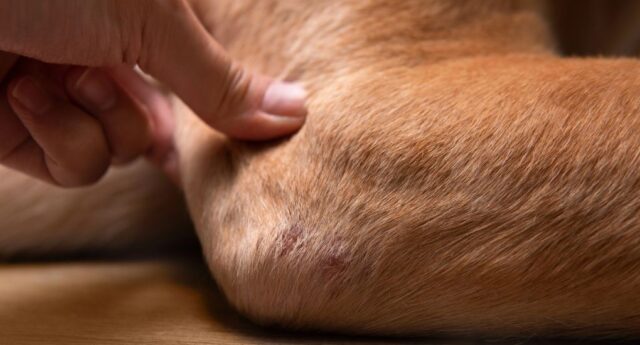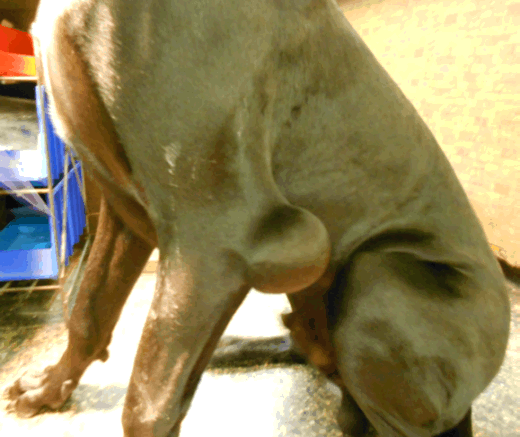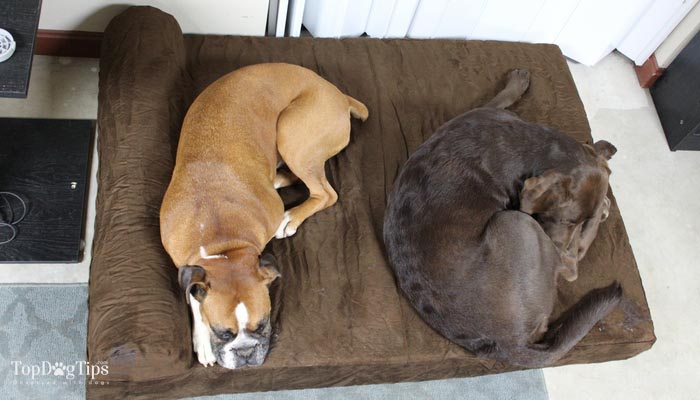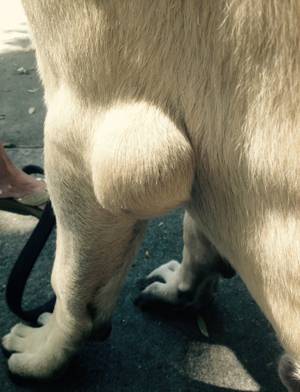
Table of Contents
Wonder what that swelling on your dog’s elbow is? It doesn’t seem to hurt when you touch it, but it looks like it should.
That can be elbow hygromas in dogs. If you want to know more about it, better scroll down!
This blog will discuss everything you need to know about elbow hygromas in dogs.
We'll cover:
- what is a hygroma
- the causes of elbow hygroma
- its signs and symptoms
- and treatments for this condition
Before any of that, you should know that large-sized dogs such as German Shepherds, Labradors, and Great Danes are more prone to Hygromas.
Now without further ado, let's get right into it! But before we discuss elbow hygromas, let's first tackle what even is a hygroma.

What is Hygroma?
Hygroma is the swelling of the skin over the pressure points and bony prominent areas of the body.
The bursa, a fluid-filled sac or saclike cavity, contains clear, yellow-to-red fluid. The swelling is often fluid-filled, immobile, and non-infectious.
Hygromas are not cysts or tumors, although they may appear similar. Hygromas are treatable and preventable after occurrence.
In some cases, some hygromas can become secondarily infected and may become infectious.
What Causes Hygromas in Dogs?
Hygromas are usually caused by repetitive trauma in the bony prominent part of the body.
The bursa, a fluid-filled sac or saclike cavity, is the inflammatory response to repetitive trauma.
This usually occurs when dogs lie down on hard surfaces or put too much weight or pressure on these areas.
Hygromas are usually found in large-breed dogs, but this can also occur in dogs who become sedentary post-surgery.
Since the dog can’t move around, they spend their time sitting down or lying around most of the time.
Hence, the pressure on their body lies on their shoulders, elbows, and pelvis most of the time.
In older dogs, flopping to the ground may cause them to have hygromas.
During this age, they may have difficulty carrying their weight and flop their body instead of sitting down gently.
What are the Symptoms of Hygromas in Dogs?
Depending on the Hygroma’s case, the appearance may vary.
Here are the symptoms to look out for:
- Small or large protruding lump in the elbow
- Soft fluctuant swelling over the elbow area (smaller and milder cases)
- Large fluctuant swelling (mid to severe cases)
- May or may not have hair thinning
- May or may not have a blister
- Unilateral or Bilateral bursa
- No lameness present
Common Areas for Hygromas in Dogs
Hygromas may occur in other parts of the body. This usually occurs where pressure points are mostly at.
Here are the common areas Hygromas may occur:
- Elbow (most common)
- Elbow — Olecranon
- Side of Dog’s Hock or Ankle Joint — Tarsus
- Hip Joint
- Near the pelvis — Ischial Hygroma

Elbow Hygromas in Dogs: A Closer Look
Hygromas are formed by damaged tissue over the elbow bones.
This is to cushion the bones from the pressure of impact and weight.
This fluid-filled sac may grow over time if left untreated.
Although elbow hygromas are not painful, it is always susceptible to secondary infection, which may greatly affect the dog’s health.
Elbow hygromas are reported to occur in large-breed dogs in less than two years of age. Dogs usually reach their full size after 24 months of age.
Symptoms for Elbow Hygromas
Depending on the Elbow Hygroma’s case, the appearance may vary.
Here are the symptoms to look out for:
- Small or large protruding lump in the elbow
- Soft fluctuant swelling over the elbow area (smaller and milder cases)
- Large fluctuant swelling (mid to severe cases)
- May or may not have hair thinning
- May or may not have a blister
- Unilateral or Bilateral bursa
- No lameness present
- No pain when touched/ stroked
If owners suspect their dog has elbow hygroma, it's best to check it out.
Owners may have difficulty determining if the lump is a hygroma on their own.
That's why it's best advised to consult your vet for guidance.
Diagnosis for Elbow Hygromas
Veterinarians may diagnose dogs with elbow hygromas by undergoing physical examination and biopsy.
These processes can help veterinarians determine whether the dog is experiencing mild, moderate, or severe hygroma.
Physical Examination
A physical examination can be the first diagnosis and examination done by the veterinarian.
The veterinarian may determine if the bursa needs other follow-up examinations to further inspect the hygroma’s condition.
Biopsy
For dogs with moderate to severe cases of Hygroma, those with physical changes and swelling or larger than normal, a biopsy can be done after a physical examination and blood test.
This can help determine if the bursa is infected.
The biopsy will also determine the proper approach for the condition’s recovery.
Elbow Hygromas in Dogs Home Remedies and Prevention
Hygromas can be prevented from occurring and recurring. This health condition can be a nuisance.
Fortunately, there are two simple, possible ways to treat or prevent this naturally.
You can try and provide an orthopedic dog bed, use padded bandages, maintain the appropriate weight, and stop your dog from lying on hard surfaces.
Weight Management
One of the best ways to prevent hygromas in dogs is to maintain their weight at average since hygromas are caused by pressuring areas of the bone on hard surfaces for long periods.
Excessive weight can cause more pressure than necessary which may cause the development of bursa in the pressured bony area.

Orthopedic Dog Beds
Another way to prevent hygromas is to avoid trauma on the area of the bursa.
Adding padding or a cushion on the dog’s bed is a great way to remove pressure on the area.
Owners can train their dogs to rest in these areas instead of lying on hard surfaces.
But another thing you can try is providing orthopedic dog beds.
Orthopedic pet beds are designed to withstand a dog's weight for years without going flat.
Generally, an orthopedic dog bed is made with high-quality memory foam relieving the stress on pressure points when dogs are lying down.
Try out the Big Barker beds! These beds are thick and an excellent option for dogs suffering from Hygromas because they cushion the joint away from hard surfaces.
The Big Barker Orthopedic Dog Bed has a headrest and a washable microsuede cover.
Owners should be keen on this, especially with adult and senior dogs.
Since these dogs are old, controlling their movements and impact may be harder when moving around.
Using Padded Bandages
Remember that it's still best to consult your vet before resorting to home remedies or nonsurgical options to treat Hygromas.
But one possible option to treat a small hygroma is to use padded bandages on the elbow.
Your vet will be able to teach you how to wrap the hygroma in these thick bandages properly.
Padded bandages can help reduce irritation and pressure on the hygroma, which can help the body a chance to heal itself.
Treatment for Elbow Hygromas
In earlier cases of elbow hygromas, veterinarians will recommend providing a softer surface to rest on for dogs to relieve pressure in these areas.
Owners may use comforters, pillows, mattress toppers, and dog sofa beds.
Veterinarians can also recommend wrapping a soft padded bandage around the elbow site.
Another alternative is providing devices that cover the elbows, such as Neoprene or Polyester sleeves.
This device is worn on the shoulders and covers the elbows with soft pads.
Treatment for more moderate to severe cases includes flushing, cold-laser therapy, surgical drainage, or bursa removal.
Regardless, if owners notice these physical changes in the dog, having their pet checked out is best.
Hygromas may not be fatal or serious as other diseases, but once it grows out or becomes infected, the dog’s health may become compromised.
Recovery from Elbow Hygromas
If your dog has undergone surgery, it can be left with a bandage on its surgery area.
This area should be capsulated and cushioned until it is healed.
It is important to avoid pressure and exposure during the recovery period.
The recovery period may take a couple of weeks to a month, depending on the dog’s immunity response to the medication and surgery.
It is important to follow-through follow up check-ups. This can help determine if your dog is responding to the medication or treatment performed by the veterinarian.
If no changes or infections have occurred, the veterinarian may modify the medication or treatment method.
It is important to be keen during this period as any secondary infection may worsen the dog’s condition.
After recovery, it’s important to make sure it does not reoccur.
When Should I Be Worried?
Occasionally, elbow hygromas can become severely inflamed, secondarily infected, and ulcerated.
Once this occurs, it may further damage the tissue in the infected part.
If the elbow hygroma becomes infected, this may lead to a painful secondary infection.
Here are some symptoms to look out for:
- Abscesses — fluids like pus are released
- Fever
- Fistulas may occur
- Folliculitis
- Granulomas
- Infection
- Lameness
- Pain
- Severe inflammation
- Bursa is warm
- Ulceration
Treatments for these cases usually consist of extensive drainage, extirpation, skin grafting, antibiotics, pain relievers, and even removal surgery to relieve the symptoms.

Frequently Asked Questions
Is hygroma serious in dogs?
The worst thing that can happen is that the hygromas can become infected. And when it becomes infected, it can be painful.
Large-sized and infected hygromas will be treated with antibiotic therapy and, in some cases, surgery.
What causes hygroma dog elbow?
The most common cause of elbow hygroma is trauma.
When a dog experience elbow trauma, such as bumping or banging the elbow too hard from hard surfaces, the dog's tissue will become inflamed.
Can dogs live with hygroma?
Yes. Even though hygromas are difficult to deal with, a dog can still live a long and happy life if their owners ensure that the dog stays comfortable and receives regular veterinary care.
Elbow Hygromas in Dogs: Before You Go…
Elbow hygromas form when the elbow experiences trauma.
Even though elbow hygromas don't cause any pain or discomfort to your dog, that doesn't mean you shouldn't treat it.
A hygroma is a fluid-filled swelling that isn't necessarily painful but can lead to infections if left untreated.
Elbow hygromas in dogs occur when the tissue is inflamed. This is like when humans swell and bruise when we bang our limbs on a hard surface.
Treatment for elbow hygromas will depend on the severity of your dog's hygroma.
For mild hygromas, there are easy, natural treatments that you can do.
The vet recommends changing your dog's bedding. Try providing an orthopedic dog bed for Fido.
Some hygromas can be drained using fine needle aspiration, and infected hygroma will need antibiotics.
On the other hand, severe cases of hygroma will require surgical drainage. Don't let it come to this point!
Just like any other health issue, elbow hygromas in dogs are best examined or treated early before they can develop into more severe problems.













